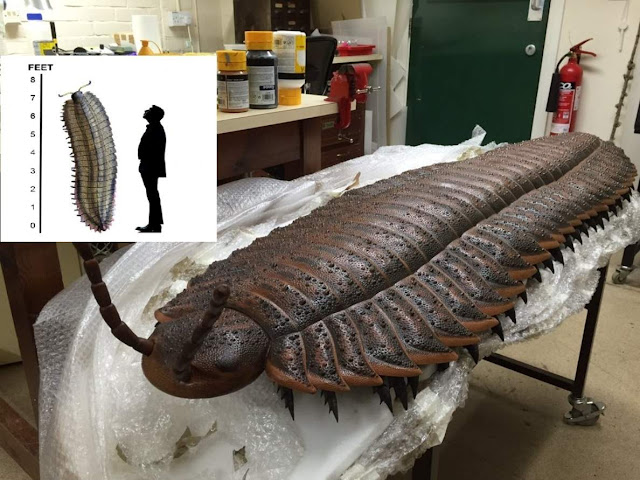
Largest Land-Dwelling “Bug” of All Time. A life size model of a giant millipede, Arthropleura
The giant extinct invertebrate Arthropleura resembled some modern millipedes, but could grow to be more than one-and-a-half feet wide, and may sometimes have been more than six feet long.
The giant extinct invertebrate Arthropleura resembled some modern millipedes, but could grow to be more than one-and-a-half feet wide, and may sometimes have been more than six feet long. Reconstruction of the giant millipede Arthropleura from the Pennsylvanian and earliest Permian of North America and Europe.

During the Pennsylvanian and earliest Permian periods (about 320 to 290 million years before present), much of present-day North America and Europe was located close to the equator and was covered by vast, richly vegetated swamps.
The remains of this vegetation ultimately formed the great coal deposits that fuelled the Industrial Revolution and to this day remain a key energy resource. These ancient swamps were home to many large arthropods including early dragonfly relatives with wingspans in excess of two feet and the subject of this blog, the giant millipede Arthropleura. One species of Arthropleura (“jointed rib”) is the largest known land-dwelling invertebrate of all time.

The flattened body of Arthropleura is composed of approximately 30 jointed segments, each of which was covered by two side plates and one center plate. The ratio of pairs of legs to body segments was approximately 8:6, similar to some present-day millipedes. Typically, the body armor of Arthropleura fell apart after the death of the animal, and only individual segments or plates were preserved as fossils.
Unfortunately, nobody has yet found a complete large individual of Arthropleura. One partial body fossil from southwestern Germany has a length of 90 cm (3 ft.). A trackway ascribed to a large Arthropleura on a Pennsylvanian-age sandstone surface from Nova Scotia (Canada) comprises two parallel rows of small imprints and is 50 cm (19.7 in.) wide.

It is estimated that the maker of this track was at least 1.7 m (5.6 ft.) long. Similar trackways have also been discovered in the United States and in Scotland. The size of some isolated armor segments indicates that Arthropleura adults could attain a length of at least 2 m (6.6 ft.).
The only even larger arthropod was the aquatic Early Devonian “sea scorpion” Jaekelopterus, which, based on one isolated chelicera (pincer-like mouth part), reached an estimated length of 2.5 m (8.2 ft.).

Fossil of Arthropleura, an extinct arthropod- Took the photo at Senckenberg Museum of FrankfurtPhoto: Sven Tränkner
Arthropleura became extinct soon after the end of the Carboniferous period, when the moist climate began drying out, reducing the rainforests of the Carboniferous, and allowing the desertification characteristic of the Permian.
The specimen is made up of multiple articulated exoskeleton segments, broadly similar in form to modern millipedes.

.

It reveals that Arthropleura was the largest-known invertebrate animal of all time, larger than the ancient sea scorpions that were the previous record holders.
There are only two other known Arthropleura fossils, both from Germany, and both much smaller than the new specimen.
“Finding these giant millipede fossils is rare, because once they died, their bodies tend to disarticulate, so it’s likely that the fossil is a molted carapace that the animal shed as it grew,” said Dr. Neil Davies, a researcher in the Department of Earth Sciences at the University of Cambridge.

“We have not yet found a fossilized head, so it’s difficult to know everything about them.”
Previous reconstructions have suggested that Arthropleura millipedes lived in coal swamps, but the new specimen showed they preferred open woodland habitats near the coast.
Dr. Davies and colleagues believe that to get to such a large size, the ancient creature must have had a high-nutrient diet.

“While we can’t know for sure what they ate, there were plenty of nutritious nuts and seeds available in the leaf litter at the time, and they may even have been predators that fed off other invertebrates and even small vertebrates such as amphibians,” Dr. Davies said.
“Arthropleura animals crawled around Earth’s equatorial region for around 45 million years, before going extinct during the Permian period.”

.

“The cause of their extinction is uncertain, but could be due to global warming that made the climate too dry for them to survive, or to the rise of reptiles, who out-competed them for food and soon dominated the same habitats.”